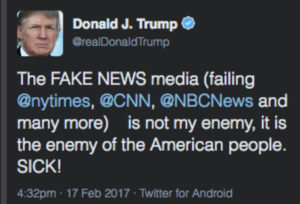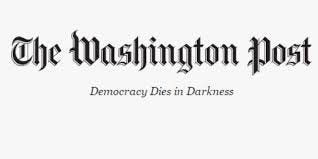
Hardly a day passes without my seeing a tweet from or about Civil, a new enterprise that will use blockchain technology and the sale of tokens to revive and sustain the badly battered journalism profession.
Reimagining the news with #blockchain-based architecture https://t.co/xx50xG4ntU
— Civil (@Join_Civil) August 24, 2018
Today the purveyors of high quality news are not only facing a fiscal crisis, but they also face an existential one resulting, in part, from daily attacks by a “President” seeking to sew doubt and plausible deniability for the moment when journalists finally uncover the definitive proof of his criminality.

In spite of Trump’s insidious campaign to denigrate the media, one would be hard-pressed to find a single educated American who does not recognize the quintessential role journalism plays in a modern democracy. Few can overstate the danger posed by those who seek to compromise the fourth estate’s Constitutionally protected role to shine a spotlight on the unscrupulous forces working against the public interest.
Just this week, a small newspaper in Georgia exposed a plan by a political operative to shutter seven of nine polling locations in predominantly African-American districts just as the state’s first African-American woman is running for governor. The public exposure led to a reversal of this scheme.
Separately, the Dallas Morning News just reported that in Texas where one needs a valid driver’s license to vote and where GOP Sen. Ted Cruz faces a serious challenge from a surging Democratic challenger Beto O’Rourke, the Texas Dept. of “Public Service” announced plans to close 87 DMV offices — four in Democratic-leaning Dallas-Fort Worth —under the incredulous guise of easing long lines. I’m hoping a little journalistic sunlight will thwart this.
While the GOP-controlled Congress has forsaken its authority to balance a swampy Executive branch, journalists must fill the void. And they are doing just that: with revelation upon revelation filling meticulously reported stories on everything from self-dealing corruption and public policies to sex scandals and blatant law breaking.
Here’s the problem: just when quality journalism is most needed, the more substantive and credible outlets leading the charge have become lessaccessible to the public. Their revelatory reporting increasingly resides behind paywalls to which most of America (outside of New York and DC) would never subscribe. Here’s a topline of what it costs to read some of today’s more respected journalistic enterprises:
- Bloomberg News: $34.99/month (after three-month promo offer)
- The Wall Street Journal: $15.60/month digital
- The New York Times: $14.95/month digital
- The Los Angeles Times: $7.96/month (after three month free trial)
- The New Yorker: $89/year digital only
- The Washington Post: $50/year basic digital
- The Atlantic: $24.99/year (special offer)
- Vanity Fair: $15/year print and digital

Many will argue that The New York Times’ 2.9 million digital subscribers now give it the financial latitude to do what it does best. In Q2 alone, the Times’s digital paywall added nearly $100 million to the news organization’s coffers. But The Times is an anomaly among U.S. newspapers, most of which don’t (or can’t) command the $14.95/month The Times does.
 What’s more, many of these high quality print/digital news organizations serve as catalysts for coverage and conversation in social media and on national cable and broadcast TV (mobile or otherwise). Fortunately, outlets like NBC News and CNN have upped their journalistic chops to investigate and break important stories.
What’s more, many of these high quality print/digital news organizations serve as catalysts for coverage and conversation in social media and on national cable and broadcast TV (mobile or otherwise). Fortunately, outlets like NBC News and CNN have upped their journalistic chops to investigate and break important stories.
It’s ironic that media outlets whose “news” content does not adhere to the tenets of journalism remain freely and broadly accessible. (I suppose you get what you pay for.) This dynamic has created an imbalance wherein propaganda and innuendo (actual “fake news”) can more easily flourish in a media ecosystem where the public self-selects what they wish to consume.
 Having worked on The New York Times’s first (ill-fated) paywall “TimesSelect,” I distinctly remember the outcry from myriad media pundits rejecting the notion of paid online content. Many still held out hope that digital advertising revenue would eventually replace the highly lucrative, but rapidly dwindling print revenue stream. It hasn’t…due to Google and Facebook.
Having worked on The New York Times’s first (ill-fated) paywall “TimesSelect,” I distinctly remember the outcry from myriad media pundits rejecting the notion of paid online content. Many still held out hope that digital advertising revenue would eventually replace the highly lucrative, but rapidly dwindling print revenue stream. It hasn’t…due to Google and Facebook.
The punditocracy now accepts the reality that quality journalism costs money and those that produce it have the right to charge for it. Yet, when quality journalism hides behind paywalls, it opens the door for dubiously reported “news” to fill the nation’s information void.
Are tokens the answer? It’s hard to say. I am buoyed by the knowledge that network news decision-makers assiduously follow these premium paradigms of journalism and others like Pro Publica, The Guardian, The Daily Beast, and Axios also devote considerable resources to ferret out the truth.
I’m much more alarmed by what’s happening at the local level where nefarious forces threaten the very existence of newspapers, which is where local TV news orgs derive their news budget and most Americans still take their news.

“All the news that’s fit to print” may remain valid, but “Democracy Dies in Darkness” likely has even greater resonance today.
” credible outlets leading the charge have become less accessible to the public.”
Huh? I remember access to newspapers and magazines (BI- Before Internet) You still had to pay for them, in fact it was much more expensive as there were were only 2 other news mediums: television and radio. People are still able to do what I did – go to your local library.